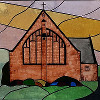One of the television programmes we have enjoyed over recent years is Britain’s Lost Masterpieces. The concept is a very simple one. Art Historian Dr Bendor Grosvenor picks out a neglected painting which he thinks might be the work of an important artist and hands it over to Simon Gillespie, a picture restorer. We watch as Simon uses solvents and cotton wool swabs to remove layers of dirty varnish and inept overpainting, before carefully touching up any damage. Once the painting has been restored to something very close to its original state, Dr Grosvenor and other experts are able to arrive at a conclusion about which artist was responsible for the work.
In today’s Gospel Jesus speaks of Nicodemus’ need to be “born from above”. In the King James Bible the passage is translated as “born again” and some Christians have taken that to mean a single and dramatic conversion experience and have even argued, wrongly I think, that you aren’t a proper Christian unless you have had that kind of experience. For some of us, the process is more gradual; perhaps the coming to a maturity in which, bit by bit, we accept and own for ourselves the religious upbringing we have received; perhaps the slow realisation that underlying the church music that we enjoy there is a profound and loving reality. That was the way my godmother, who declared herself to be an atheist shortly after escorting my infant self to the font, came to faith towards the end of her life.
It may be more helpful to think about the meaning of that phrase “born from above” by using picture restoration as a metaphor. As a devout member of the religious establishment, Nicodemus knew the Hebrew Bible. He had read and reflected on the passage in Genesis which teaches that human beings are made in the image and likeness of God. What Jesus is suggesting is that, in Nicodemus, that image and likeness had become obscured, perhaps by the over-confidence that can afflict religious leaders, perhaps by a lack of charity. Nicodemus was in short, like all of us, in need of a clean-up, in need of the kind of restoration that would reveal in him the image and likeness of his Creator.
Pictures cannot restore themselves to their original splendour, and neither can we by our own unaided efforts. That is the point that St Paul is making in today’s Epistle, when he makes a distinction between works and faith. It is only by placing our trust in God’s ability to cleanse and restore us that the cleansing and restoration become possible. And Lent is a time when we are reminded of that need for trust, a time to open ourselves by prayer and reflection to the grace of God and to the cleansing and restoration that God’s grace makes possible.
Jesus then goes on to say some very challenging things to Nicodemus, and the challenges reach a climax with these words:
“For God so loved the world that he gave his only Son, so that everyone who believes in him may not perish but have eternal life.”
It’s a verse which is often read in an “us and them” way – “believe in Jesus and you’ll go to heaven, fail to believe in Jesus and you will be damned.”
And that’s a reading which can very easily turn into the kind of religious comfort zone out from which Jesus was trying to draw Nicodemus. The purpose of God’s self-giving, universal and unconditional love is to evoke from human beings a love of exactly the same kind. And Christians do not have a monopoly on that kind of love. As Archbishop William Temple put it:
“Whatever promotes among men love and joy and peace has its source in that divine love which sent the Son into the World, not to judge the world, but that the world may be saved through him.”
The world, not just individual Christians. And the Greek word which is translated as “the world” is kosmos – suggesting the whole of creation.
When St Athanasius, that great fourth century Christian thinker, wanted to explain the reason for the Incarnation, for God’s giving of his only Son, he turned to the idea of picture restoration. Suppose, he suggested, that the portrait of someone is so badly damaged that it is impossible to restore it unless that person can be traced and can sit as a model for the restorer. That is what had happened to humankind.
The image and likeness of God had become so overpainted with selfishness and greed that human beings had lost sight of it in themselves and in other people. Until, that is, Jesus came to show us that image and likeness in reality, in his words and actions and in his Passion and to give us an understanding of what God intends us to be. If we respond to that reality, then God’s work of restoration can proceed.
Athanasius put it like this:
“Even the wood on which the artist painted is not thrown away, but the outline is renewed upon it; in the same way also, the most holy Son of the Father, came to our region to renew humanity once made in his likeness.”
A thought that John Keble took up when he wrote the hymn Blest are the pure in heart.
“The Lord who left the heavens
Our life and peace to bring,
To dwell in lowliness with us,
Our pattern and our King.”
